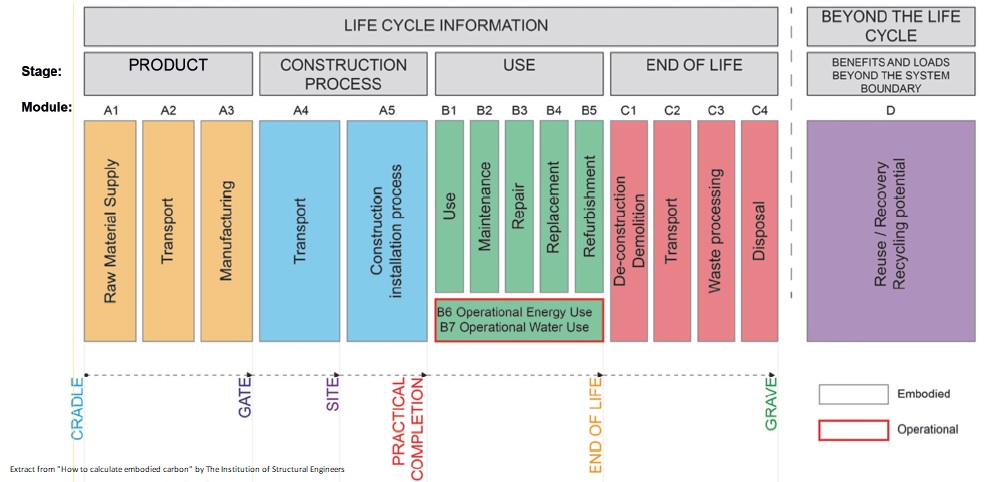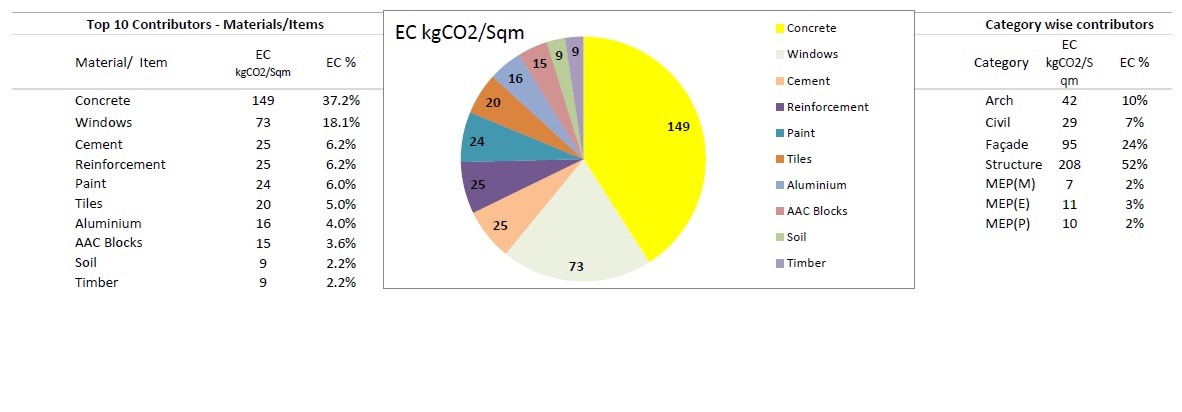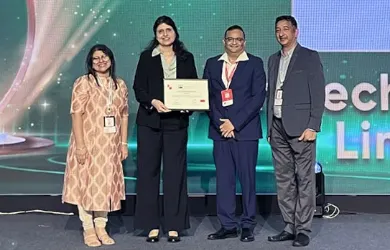- Our Story
- Our Impact
-
Our Projects
Commercial
- Careers
Embodied carbon in high rise buildings - Insights from a baselining study
By Dr. Prasad Marepalli & AUN ABDULLAH
August 30, 2022Dr. Prasad Marepalli, Head of Structural Engineering
Aun Abdullah, Head of Sustainability
The latest IPCC report states that the anthropogenic greenhouse gasses emissions (GHG), leading to global warming, are causing dangerous and widespread disruption in nature and are affecting the lives of billions of people around the world. While buildings contribute to almost 40% of overall global GHG emissions, a large portion of these emissions get locked in at the time of construction of the building itself, also known as embodied carbon. Embodied carbon, or upfront carbon contributes to around 15%-30% of lifecycle emissions in the built environment. Hence, it is essential to curb the use of carbon intensive materials before they lock-in the associated carbon in the environment. The booming urbanization and the fact that we are at the start of the 10-15 year up-cycle in the housing market, makes the need for this transition all the more timely.

The famous saying, "you can't manage what you can't measure", is apt for embodied carbon as most of the emissions happen during the extraction of materials, manufacturing or assembling processes and various instances of transportation of the material; and accurate data on all these stages is hard to ascertain. In the absence of transparent recording and disclosure of these emissions the engineering teams have to rely on databases from ICE, IFC, EC3, etc. While these databases are diligently compiled by the author institutions, there are issues of regional bias, and the risk of generalization of emissions factors remains a critical issue. Certain LCA software do have references to multiple databases as an attempt to manage these differences.
At Lodha, we decided to measure embodied carbon emissions across our projects as a baselining exercise. In this process we encountered data hurdles including absence of data in the Indian context as well as the reliability of the available data. It will be fair to clarify that this is not a problem specific to the Indian market, rather this is a global issue; and it is clearly reflected in the fact that there are very few reliable embodied carbon benchmarks even in those markets that claim to have good EPD reporting culture.
We engaged CII-GBC to estimate the embodied carbon in high rise concrete buildings and selected a few representative buildings for the study. We realized that we should come up with a template that captures the materials in a manner that can be used to calculate embodied carbon for any project and also track the evolution of embodied carbon coefficients per material type as they become more accurate i.e. from a 'generic database reference' to 'actual environmental performance data (epd)' from the manufacturer.
The summary of the results from that exercise is given as follows:

This gave insights on the following important aspects:
1. Major contributors of embodied carbon were identified, to help us focus and prioritize our embodied carbon reduction goals
2. Our baseline embodied carbon emissions are in the range of 400-415kgCO2e/m2 of construction area
3. Cement and concrete are the primary materials that account for 45% of overall embodied carbon emissions and should be the priority focus area
4. Last mile transportation related emissions from the manufacturer to the site was found to be less than 1%, therefore not a significant focus area to begin with
5. Recycling technologies upholding the quality of the materials are essential to replace the need of virgin materials such as steel and aluminum
The template developed during this exercise is comprehensive in nature with provision to account emissions for generally used materials in a typical high rise development. Some salient features of this template are:
1. Materials are sub-categorized as per usage types, considering different emissions factors for different manufacturing processes
2. Embodied Carbon (EC) coefficient and the source of reference are indicated to track future updates
3. Mode of transportation and associated emissions are also covered
4. The template is also scalable as it can be expanded for more materials and processes to suit any construction types (Composite steel structures, precast buildings, infrastructure facilities, etc.)
We are regularly engaging with our supply chain to refine the EC emission factors and are hopeful of a continual improvement in accuracy of the exercise. We suggest users to not only follow this template as a reference, but also reach out to us in case they arrive at a more accurate EC emission factor for any material. Our belief is that only by mainstreaming EC calculations will we be able to drive the supply chain towards such data transparency that can not only result in higher accuracy but it will also aid the much needed action in reducing the embodied emissions collaboratively.
Guided by our vision of 'Building a Better Life' we are committed to be carbon neutral in our operations by 2035. Right from the beginning sustainability has been at the core of our business. We have partnered with RMI to establish "Lodha Net Zero Urban Accelerator" with an aim to mainstream net zero carbon emissions in the built environment. It works on five focus areas including Embodied Carbon, Passive Designs, Equipment Efficiency, Renewable Transition and Green Mobility with a cross cutting strand of Green Finance. We have also partnered with Xynteo on the "Build Ahead" coalition that aims to bring together multiple stakeholders from the construction value chain in India including producers, consumers, financiers, and technology providers to accelerate the use of low-carbon building materials, with the goal to support India in achieving its net-zero targets by 2070.
You can reach out to us on sustainability@lodhagroup.com
You may also like





 Enquire
Enquire
 Call
Call
 chat
chat





